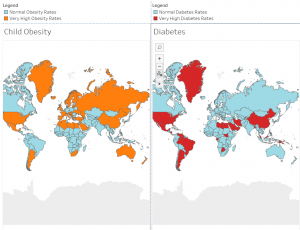
by Anas Sidani | Apr 24, 2022 | Dashboard, Visualization
Rafic Srouji, Lara Zbibo, Anas Sidani, Dima Daouk, Ziad Moghabghab, Celine Kabbara
As MSBA students, we are used to working with data daily, we are accustomed to hearing about its importance and how it holds the answers to any question we might have. We didn’t really understand how powerful data was until we were asked a question we didn’t have the answer to, and with the use of data we were able to unearth the answers to our question.
It was Monday February 22, directly after our Data visualization class, we were walking from OSB to Zaituna Bay and we were discussing different potential ideas for our upcoming visualization course when suddenly we were stopped by a SkyNews reporter. He asked us if we were students and then proceeded with asking us the one question that captured our curiosity:
Luckily, they included MSBA’s one and only Rafic Srouji in the news report the next day. His answer was:
This whole interaction got us thinking and sparked our curiosity; we wanted to find out why is the cost of consumer goods drastically increasing and what can we do about it.
As residents of Lebanon, we experienced first-hand the dramatic rise of prices every time the Lira devalues with an average inflation rate of 132.98%, so we joined the monthly inflation rate data in Lebanon with the monthly Lira rate data from 2019 till 2022. After plotting the timeseries data, we found that when the lira rate increases the inflation rate increases substantially. With further research, we found that the price of consumer goods changes substantially with the fluctuation of the lira because most consumer goods are imported, thus being purchased with the USD.
In order to get more insights about the nature of the trade deficit (exports and imports), we analyzed the Lebanese exports and imports data. This enabled us to create charts that compare the import and export values in Lebanon, and to divide them by sector.
As we can see in the dashboard’s charts, Lebanon has a large trade deficit of $12.81 Billion with most consumer goods being imported, this definitely plays a huge role in the increase of prices. If Lebanon was more self-sufficient when it comes to consumer goods and other basic products, the price of said products could potentially decrease and would be less volatile to changes in the lira rate.
Lebanon imports 20% of its total imports from the Agriculture sector, as well as 20% from the Minerals sector, which both constitutes to its highest imports. Our focus as to evaluate whether this amount could be reduced.
A big discovery was found! Lebanon has opportunities all over its area, hidden in its chaos; the country has at least one available factory that can produce goods from any tradeable sector. Lebanon has more than enough factories to reach the dream of putting a dent in the trade deficit. The country has 1,616 factories in the food industry that can dramatically decrease the high prices of food and beverages, if properly exploited.
A comparison between Turkey and Lebanon was found to be a great validation to our proposed solution. Turkey’s Lira has lost more than 70% of its value since 2021, but it was found that the inflation rate didn’t follow as aggressively as that of Lebanon. The weaker correlation between the Turkish Lira rate and the Turkish inflation rate is a direct result of the strong local production in Turkey. Turkey has a negligible trade deficit of $29 million which is negligible in comparison to its population (85 million), in opposite to Lebanon who has a trade deficit of $12.82 billion with a population of 6.83 million.
Local production is a key player in decreasing Turkey’s yearly trade deficit. Improving local production is seen to be effective in decreasing the country’s trade deficit, and decreasing the prices of goods.
From here, our findings demonstrate that there is a crucial need for local production. To do so, the government must allocate resources towards these factories and exploit them, especially in times we need them the most. This would potentially increase tourism, increase local jobs, and decrease prices all together.

by Anas Sidani | Apr 15, 2022 | Uncategorized
How would you feel?
If I told you that somewhere around the world infants are getting injected with a vile poison. A venom that doesn’t kill immediately rather it slowly cripples the child, taking away his/her quality of life and decreases his/her life expectancy by 15 years. How would you feel? Would you burst in tears? Punch a wall and recite every swear word in the dictionary? Or even make it your life’s goal to put an end to this monstrosity? Well, I want you to remember those feelings very well while reading the rest of this vlog, because the story I told might not be perfectly real but it holds a lot of truth.
Children & Obesity
More than 19% of children suffer from obesity worldwide which adds up to a frightening 14.4 million children. Four out of five of those children will remain obese as adults which will result in them losing 15-20 years of life on average. Are you starting to get the analogy and to connect the dots? Children aren’t getting injected with crippling poison, but they are getting exposed to crippling quantities of food with poison like nutritional values. I got interested in the subject of obesity in children after plotting 2 maps using the WDIData. One map for the obesity rates in children worldwide, and the other for the diabetes rates worldwide. What I found was shocking. I found that most countries with higher than average obesity rates in children has higher diabetes rates (as can be seen in the plot below).
.
After doing some research (because of my findings), I concluded that an obese child is a diabetic adult in the making. Obese children face four times the risk of developing type 2 diabetes which is a leading cause of death worldwide (9th). Why isn’t obesity in children treated like the atrocity it is? I believe that feeding children unhealthy foods is akin to giving them a cigarette and telling them to light up.
What should we do?
After some research, I found that the most prominent solution and the one most sworn by is awareness. Awareness for the children at schools about healthy lifestyle and the importance of fitness, and more importantly awareness for the parents regarding obesity and its repercussions, healthy living, and


